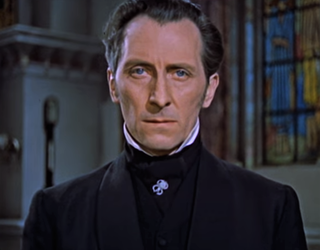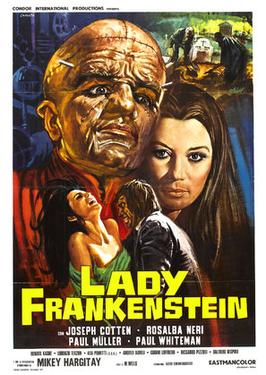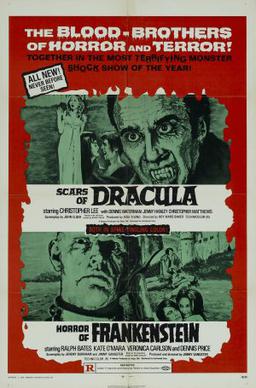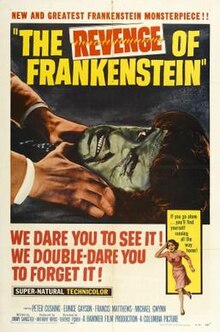
Peter Wilton Cushing was an English actor. His acting career spanned over six decades and included appearances in more than 100 films, as well as many television, stage and radio roles. He achieved recognition for his leading performances in the Hammer Productions horror films from the 1950s to 1970s, and as Grand Moff Tarkin in Star Wars (1977).
Hammer Film Productions Ltd. is a British film production company based in London. Founded in 1934, the company is best known for a series of Gothic horror and fantasy films made from the mid-1950s until the 1970s. Many of these involve classic horror characters such as Baron Victor Frankenstein, Count Dracula, and the Mummy, which Hammer reintroduced to audiences by filming them in vivid colour for the first time. Hammer also produced science fiction, thrillers, film noir and comedies, as well as, in later years, television series.

Young Frankenstein is a 1974 American comedy horror film directed by Mel Brooks. The screenplay was co-written by Brooks and Gene Wilder. Wilder also starred in the lead role as the title character, a descendant of the infamous Dr. Victor Frankenstein. Peter Boyle portrayed the monster. The film co-stars Teri Garr, Cloris Leachman, Marty Feldman, Madeline Kahn, Kenneth Mars, Richard Haydn, and Gene Hackman.

Dracula is a 1958 British gothic horror film directed by Terence Fisher and written by Jimmy Sangster based on Bram Stoker's 1897 novel of the same name. The first in the series of Hammer Horror films starring Christopher Lee as Count Dracula, the film also features Peter Cushing as Doctor Van Helsing, along with Michael Gough, Melissa Stribling, Carol Marsh, and John Van Eyssen. In the United States, the film was retitled Horror of Dracula to avoid confusion with the U.S. original by Universal Pictures, 1931's Dracula.

Terence Fisher was a British film director best known for his work for Hammer Films.

The Curse of Frankenstein is a 1957 British horror film by Hammer Film Productions, loosely based on the 1818 novel Frankenstein; or, The Modern Prometheus by Mary Shelley. It was Hammer's first colour horror film, and the first of their Frankenstein series. Its worldwide success led to several sequels, and it was also followed by new versions of Dracula (1958) and The Mummy (1959), establishing "Hammer Horror" as a distinctive brand of Gothic cinema.

Victor Frankenstein is a fictional character and the main protagonist and title character in Mary Shelley's 1818 novel, Frankenstein; or, The Modern Prometheus. He is a Swiss scientist who, after studying chemical processes and the decay of living things, gains an insight into the creation of life and gives life to his own creature. Victor later regrets meddling with nature through his creation, as he inadvertently endangers his own life and the lives of his family and friends when the creature seeks revenge against him. He is first introduced in the novel when he is seeking to catch the monster near the North Pole and is saved from near death by Robert Walton and his crew.

Igor, or sometimes Ygor, is a stock character, a sometimes hunch-backed laboratory assistant to many types of Gothic villains or as a fiendish character who assists only himself, the latter most prominently portrayed by Bela Lugosi in Son of Frankenstein (1939) and The Ghost of Frankenstein (1942). He is familiar from many horror films and horror film parodies. He is traditionally associated with mad scientists, particularly Victor Frankenstein, although Frankenstein has neither a lab assistant nor any association with a character named Igor in the original Mary Shelley novel. The Igor of popular parlance is a composite character, based on characters created for the Universal Studios film franchise. In the first Frankenstein film (1931), Fritz served the role; in subsequent sequels, a different physically deformed character, Ygor, is featured, though Ygor is not an assistant in those films.

Frankenstein Must Be Destroyed is a 1969 British horror film directed by Terence Fisher for Hammer Films, starring Peter Cushing, Freddie Jones, Veronica Carlson and Simon Ward. The film is the fifth in a series of Hammer films focusing on Baron Frankenstein, who, in this entry, terrorises those around him in a bid to uncover the secrets of a former associate confined to a lunatic asylum.

The Evil of Frankenstein is a 1964 film directed by Freddie Francis. The third instalment in Hammer's Frankenstein series, it stars Peter Cushing, Sandor Elès and Kiwi Kingston.

Frankenstein Created Woman is a 1967 British Hammer horror film directed by Terence Fisher. It stars Peter Cushing as Baron Frankenstein and Susan Denberg as his new creation. It is the fourth film in Hammer's Frankenstein series.

House of Frankenstein is a 1944 American horror film starring Boris Karloff, Lon Chaney Jr. and John Carradine. Based on a story by Curt Siodmak, it was directed by Erle C. Kenton and produced by Universal Pictures.

Lady Frankenstein is a 1971 Italian horror film directed by Mel Welles and written by Edward di Lorenzo. It stars Rosalba Neri, Joseph Cotten, Mickey Hargitay and Paul Müller.

The Horror of Frankenstein is a 1970 British horror film by Hammer Film Productions that is both a semi-parody and semi-remake of the 1957 film The Curse of Frankenstein, of Hammer's Frankenstein series. It was produced and directed by Jimmy Sangster, starring Ralph Bates, Kate O'Mara, Veronica Carlson and David Prowse as the monster. It was the only film in the Frankenstein series which did not star Peter Cushing. The original music score was composed by Malcolm Williamson.

Frankenstein and the Monster From Hell is a 1974 British horror film, directed by Terence Fisher and produced by Hammer Film Productions. It stars Peter Cushing, Shane Briant and David Prowse. Filmed at Elstree Studios in 1972 but not released until 1974, it was the final chapter in the Hammer Frankenstein saga of films as well as director Fisher's last film.

Lust for a Vampire, also known as Love for a Vampire or To Love a Vampire, is a 1971 British Hammer Horror film directed by Jimmy Sangster, starring Ralph Bates, Barbara Jefford, Suzanna Leigh, Michael Johnson, and Yutte Stensgaard. It was given an R rating in the United States for some violence, gore, strong adult content and nudity. It is the second film in the Karnstein Trilogy, loosely based on the 1872 Sheridan Le Fanu novella Carmilla. It was preceded by The Vampire Lovers (1970) and followed by Twins of Evil (1971). The three films do not form a chronological development, but use the Karnstein family as the source of the vampiric threat and were somewhat daring for the time in explicitly depicting lesbian themes.

Mary Shelley's 1818 novel Frankenstein; or, The Modern Prometheus, and the famous character of Frankenstein's monster, have influenced popular culture for at least a century. The work has inspired numerous films, television programs, video games and derivative works. The character of the Monster remains one of the most recognized icons in horror fiction.

The Man Who Could Cheat Death is a 1959 British horror film, directed by Terence Fisher and starring Anton Diffring, Hazel Court, and Christopher Lee. Jimmy Sangster adapted the screenplay from the play The Man in Half Moon Street by Barré Lyndon, which had been previously filmed in 1945. The Man Who Could Cheat Death was produced by Michael Carreras and Anthony Nelson Keys for Hammer Film Productions. It was released in the US on 19 August 1959 and in the UK on 30 November 1959.

Tales of Frankenstein is an unsold TV pilot filmed in 1958. It was a co-production of Hammer Film Productions and Columbia Pictures. The film is a mixture of elements from both the Hammer and Universal Pictures versions of Frankenstein, based on Mary Shelley's 1818 novel Frankenstein; or, The Modern Prometheus. The episode title, which does not appear onscreen, is "The Face in the Tombstone Mirror". The film is in the public domain.
Frankenstein is a British horror-adventure film series produced by Hammer Film Productions. The films, loosely based on the 1818 novel Frankenstein; or, The Modern Prometheus by Mary Shelley, are centered on Baron Victor Frankenstein, who experiments in creating a creature beyond human. The series is part of the larger Hammer horror oeuvre.



















